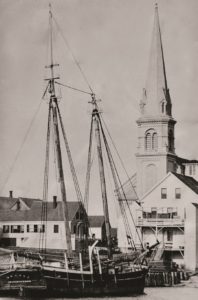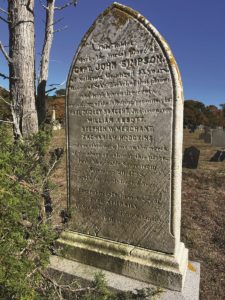What came to be known as the Long Storm of 1798 arrived on the New England coast on Nov. 17. One Portsmouth, N.H. newspaper, under the headline “Violent Snow Storm,” reported, “On Saturday evening last, commenced a violent Snow Storm; Sunday it abated, Sunday night it increased to greater violence and the wind blew excessively hard from the N.E. The tempest continued all day on Monday, Tuesday, and Wednesday, and on the evening of Wednesday the weather cleared up. The quantity of snow which fell seems almost incredible, and the oldest people assert that they never knew such a storm so early in the season.
“We fear that many fatal consequences have resulted to our seafaring brethren,” the reporter added, “but none as yet have came [sic] to our personal knowledge, except the brig Hope.”

The brig Hope, sailing from Demerara — then British Guiana, now the independent nation of Guyana — in South America with a cargo of rum, coffee, and sugar, was driven onto the beach at Hampton, N.H. with no loss of crew or cargo.
The newly built Rachel, owned by Capt. John Simpson, a prominent citizen of Sullivan, Maine, was not as fortunate — one of the “fatal consequences” of the storm. The Rachel was carrying a cargo of lumber when it sailed in mid-November from Sullivan en route to Salem, Mass. The crew was made up of William Abbott, Stephen W. Merchant, Zachariah Hodgkins, and James Springer.
Also on board was a passenger, 19-year-old Paul Dudley Sargent, a member of the prominent Sargent and Winthrop families and the son of a distinguished Revolutionary War soldier. It was reported that Paul was on his way to Salem to attend school.
During the voyage, the Rachel had kept company along the coast of Maine with the schooner Diana, commanded by Capt. John Simpson’s brother Josiah, until the severity of the storm persuaded Josiah to seek refuge. John Simpson, believing that he could reach Salem before the full force of the storm was upon him, made the ill-fated decision to push on, steering out to sea and away from land, only to be caught — as hundreds of vessels would be over the next century — in the clutches of Cape Cod’s bended arm and treacherous shifting sand bars.

At Highland Lighthouse, the wooden sentinel that had been activated just a year earlier (and would be replaced in 1857 by the one that now stands in Truro), Keeper Isaac Small found seven vessels ashore, among them the Rachel. Reports told of 25 bodies recovered on Cape Cod as a result of the storm.
Soon after the wreck, Capt. Simpson’s brother-in-law, Capt. James Sullivan, visited Truro’s Old North Cemetery. Accompanied by Truro native Jesse Collins (1766-1823), Capt. Sullivan was shown the spot where the Rachel crew had been interred, erected a slate marker, and was given several items that had been found on the crew members, all of whose bodies had been recovered.
Included among the items was a sealskin trunk, a pearl-handled pocketknife, and a handkerchief belonging to Capt. John Simpson, said to have been tucked into his pocket by his five-year-old daughter, Rachel, on the day he had sailed.
Eight decades later, in the summer of 1878, John S. Emery (1816-1895), a prominent businessman and principal of the well-known ship brokerage J.S. Emery & Co. of Boston, traveled with his brother Erastus to Truro. They likely came as passengers on the Old Colony Railroad, which had been extended to Provincetown in 1873. For the brothers, the journey was a pilgrimage to visit the grave of their maternal grandfather, John Simpson.
Although nearly 80 years had passed since that long nor’easter of 1798 and the wreck of the Rachel near the Highland cliffs, one imagines that stories of Capt. Simpson and his schooner, named for his wife, Rachel, born a Sullivan, had consumed the childhoods of the Emery brothers.

In Truro, the captain’s grandsons were accompanied to the Old North Cemetery by Capt. Jesse Collins (1795-1886) and his sister, Miss Polly Collins (1804-1884), the elderly children of the senior Jesse Collins, who had assisted Capt. James Sullivan when he had come to bury the Rachel’s crew.
Returning to Boston, the Emery brothers commissioned a large Italian marble tablet from Messrs. Bowker, Torrey & Co., inscribed with the detailed story of the Rachel. Set on a base made from granite quarried in Sullivan, Maine near the home of Capt. Simpson, the tablet was placed in the Old North Cemetery in the fall of 1878.
At the time the tablet was being inscribed, seaman James Springer had not been identified and was listed as “one other” on the stone. Historian Edward Rowe Snow, in his 1946 classic, A Pilgrim Returns to Cape Cod, tells the story of the Rachel and notes that, having been made aware of the name of the “other” crewmember, he made arrangements to place the name of James Springer on the Rachel tablet where “it rightfully belonged.” Alas — it never happened.



